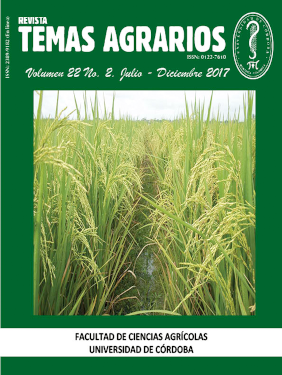Gibberellic acid efect on growing, quality and yielding of tomato plants under controlled conditions
Efecto del ácido giberélico en el crecimiento, rendimiento y calidad del tomate bajo condiciones controladas

This work is licensed under a Creative Commons Attribution-NonCommercial 4.0 International License.
Show authors biography
This study aims at evaluating the effect of gibberellic acid (AG3) on tomato development, yield and quality under controlled conditions. The study was carried out in the Granja Tesorito property of the University of Caldas located in the municipality of Manizales (Colombia). The experimental design was randomized completely (DCA) with a 2x4 factorial arrangement with two hybrids ("Alboran" and "Torrano") and four concentrations of gibberellic acid (AG3) (0, 50, 100 and 150 ppm), with 4 replicates and as an experimental unit 9 plants were evaluated per replicate. The variables evaluated were: height (cm), appearance of the last flower (days), number of clusters, length of internodes (cm), yield, quality production and losses in kg ha-1. The results showed an inverse relation between the yield and days at the last bloom for both hybrids at the evaluated concentrations of AG3, where the "Alboran" milano hybrid at concentrations of 0 ppm showed the highest production with 19660,1 kg ha-1, and the highest time to last bloom with 98 days. Similar behavior of the "Torrano" hybrid at a concentration of 0 ppm was found, yielded a superior yield with 16261.8 kg ha-1 and 98 days at last flowering. The hormone application concentrations evaluated in the present study showed a detrimental effect on yield and crop quality.
Article visits 2028 | PDF visits
Downloads
- Agüero, M., Granell, A. y Carbonell, J. 1996. Expression of thiol proteases decreases in tomato ovaries after fruit set induced by pollination or gibberellic acid. Plant Physiology, 98: 235-240.
- Anuario meteorológico Cafetero 2012. 2013. Federación Nacional de Cafeteros de Colombia. Centro Nacional de investigaciones en Café. CENICAFE, Chinchiná (Colombia).
- Arbeláez, L., Rivera, J., Hurtado-Salazar, A. y Ceballos-Aguirre, N. 2016. Technical and Economic Evaluation of Three Types of Tomato Nutrient Solutions under Semi-Controlled Conditions. Journal of Agricultural Science; 8(8): 68-78. doi:10.5539/jas.v8n8p68
- Bari, R. y Jones, J. 2009. Role of plant hormones in plant defence responses. Plant Molecular Biology, 69:473–488. Doi: 10.1007/s11103-008-9435-0
- Bertolin, D., Sá, M., Arf, O., Furlani, E., Colombo, A. y Carvalho, F. 2010. Aumento da produtividade de soja com a aplicação de bioestimulantes. Bragantia, 69(2): 339-347. http://dx.doi.org/10.1590/S0006-87052010000200011.
- Caputo, M., Silva, M., Beauclair, E. y Gava, G. 2007. Acúmulo de sacarose, produtividade e florescimento de cana-de-açúcar sob reguladores vegetais. Interciência, 32: 834-840.
- Carvalho, S. y Vasconcelos, M. 2013. Producing more withless: strategies and novel technologies for plant-based food biofortification. Food Research International, 54: 961–971. doi:10.1016/j.foodres.2012.12.021
- FAOSTAT. 2016. FAO Statistical Databases. Retrieved November 26, 2016, from http://faostat.fao.org
- González, M., Caycedo, C., Velásquez, M., Flórez, V. y Garzón, M. 2007. Efecto de la aplicación del ácido giberélico sobre el crecimiento del coliflor (Brassica oleraceae L.) var. Botrytis DC. Agronomía Colombiana, 25(1): 54-61.
- IFPRI - International Food Policy Research Institute. 2014. Producing More With Less? Available at: http://www.ifpri.org/blog/producing-more-less.
- Kataoka, K., Uemachi, A. y Yazawa, S. 2003. Fruit growth and pseudoembryo development affected by uniconazole, an inhibitor of gibberellin biosynthesis, in pat-2 and auxin-induced parthenocarpic tomato fruits. Scientia Horticulturae 98: 9-16.
- Larcher, W. 2006. Ecofisiologia vegetal. São Carlos: Rima, p.295-338.
- Magalhães, J., Ferreira, E., Oliveira, M., Pereira, A., Silva, D. y Santos, J. 2016. Effect of plant-biostimulant on cassava initial growth. Revista Ceres, 63(2): 208-213. http://dx.doi.org/10.1590/0034-737X201663020012
- Miranda, D., Fischer, G., Carranza, C., Rodríguez, M., Lanchero, O. y Barrientos, J.C. 2009. Characterization of productive systems of tomato (Solanum lycopersicum L.) in producing zones of Colombia. Acta Horticulturae, 821: 35-46. http://dx.doi.org/10.17660/ActaHortic.2009.821.2
- Nemhauser, J., Hong, F. y Chory, J. 2006. Different Plant Hormones Regulate Similar Processes through Largely Nonoverlapping Transcriptional Responses. Cell, 126(3): 467-475. http://dx.doi.org/10.1016/j.cell.2006.05.050
- Perilla, A., Rodríguez, L. y Bermúdez, L. 2011. Estudio técnico-económico del sistema de producción de tomate bajo invernadero en Guateque, Sutatenza & Tenza (Boyacá). Revista Colombiana de Ciencias Hortícolas, 5(2): 220-232. http://dx.doi.org/10.17584/rcch.2011v5i2.1269
- Rademacher, W. 2000. Growth retardants: effects on gibberellin biosynthesis and other metabolic pathways. Annual Review of Plant Physiology and Plant Molecular Biology, 51: 501–531.s.eu/ [accessed 23 November 2016].
- Salisbury F. y Ross C. 2000. Fisiología de las Plantas. Tomo 3. Desarrollo de las Plantas y Fisiología Ambiental. Editorial Thomson-Paraninfo, p. 413.
- SAS. 1992. In: SAS Institute Cary, N.C. EEUU. Version 9.0.
- Silva, M., Gómez, H., Zavala, F., Cuevas, B. y Rojas, M., 2011. Efecto de cuatro fitorreguladores comerciales en el desarrollo y rendimiento del girasol. Ciencia UANL, 4(1): 69-75.
- Taiz, L. y Zeiger, E. 2004. Fisiologia vegetal. 3 edição. Porto alegre – Artmed, p. 613-641.
- Talaat, I., Khattab, H., Ahmed, A. 2013. Changes in growth, hormones levels and essential oil content of Ammi visnaga L. plants treated with some bioregulators. Saudi Journal of Biological Sciences, 21(4): 355-365. https://doi.org/10.1016/j.sjbs.2013.10.008
- Yue, L., Tian-lai, L. y Dan, W. 2008. Correlation Between Endogenous Hormones of Stem Apices and Fruit Locule Numbers in Tomatoes During Floral Bud Differentiation Stages, Agricultural Sciences in China, 7(4): 447-454. http://dx.doi.org/10.1016/S1671-2927(08)60088-7.




















